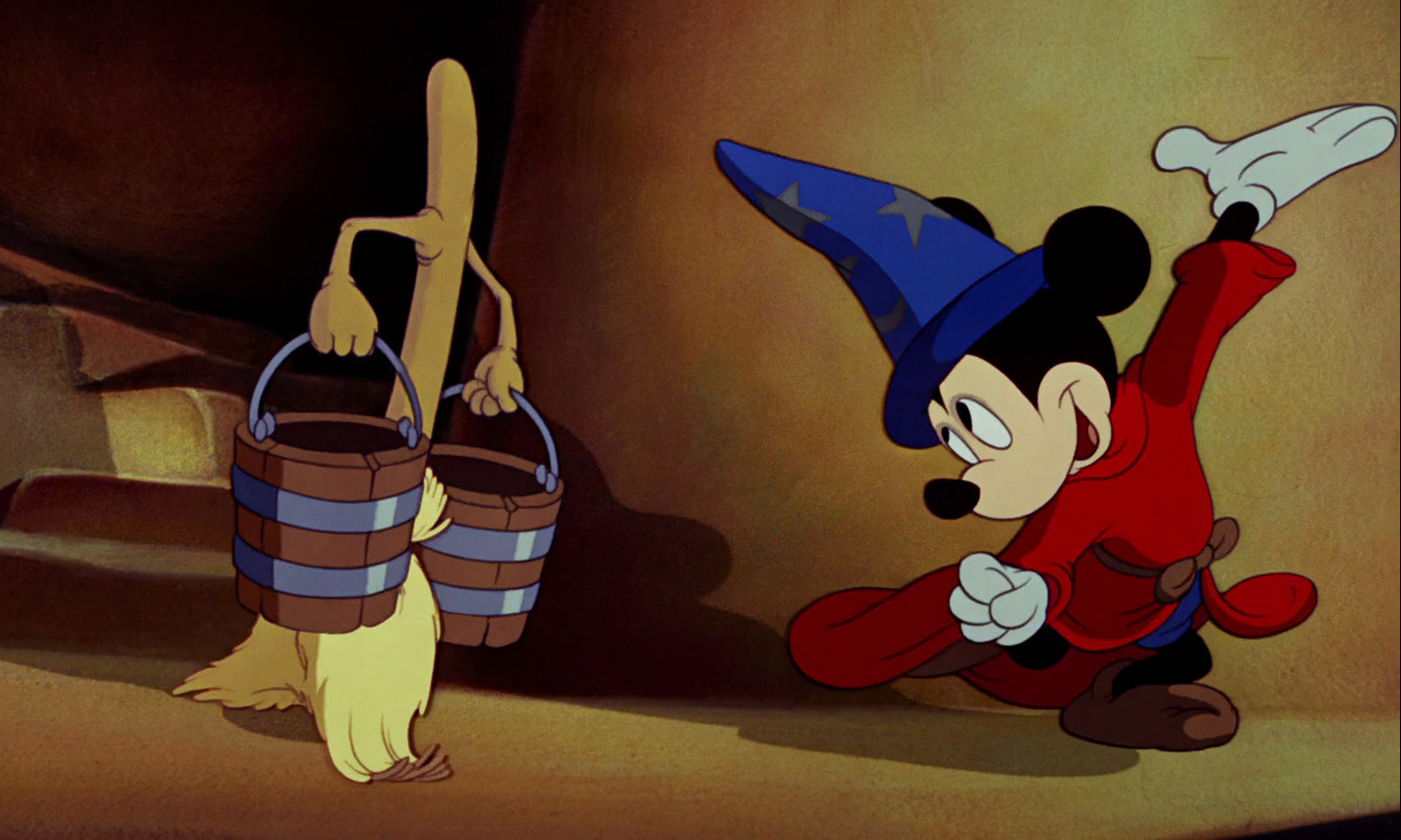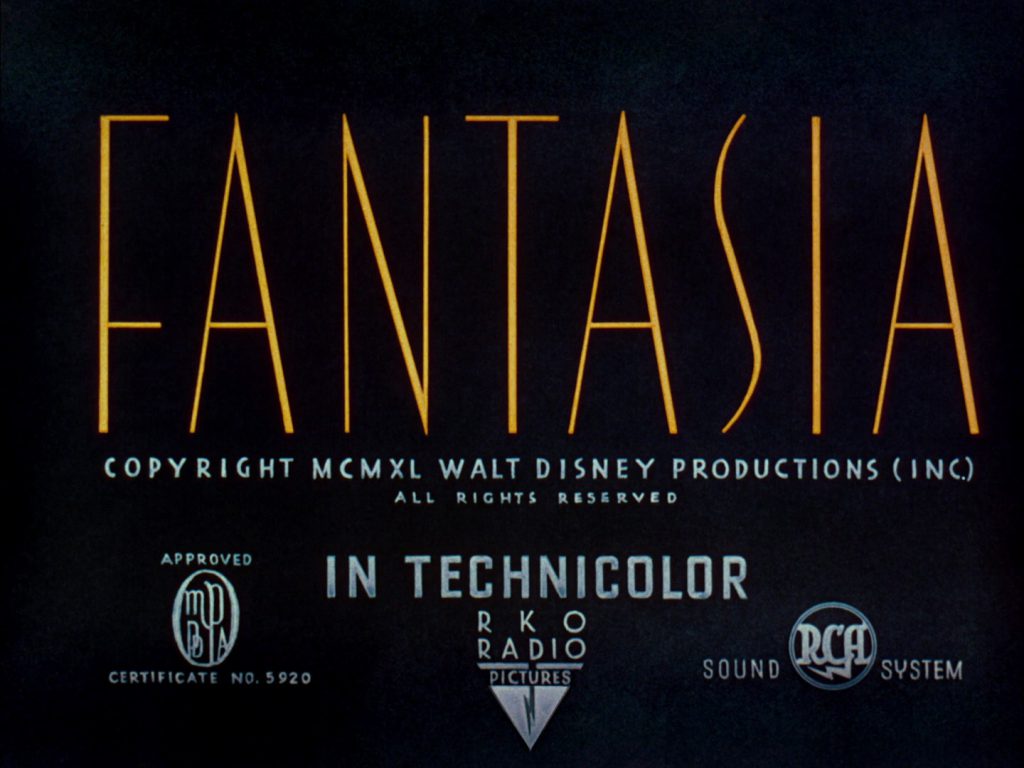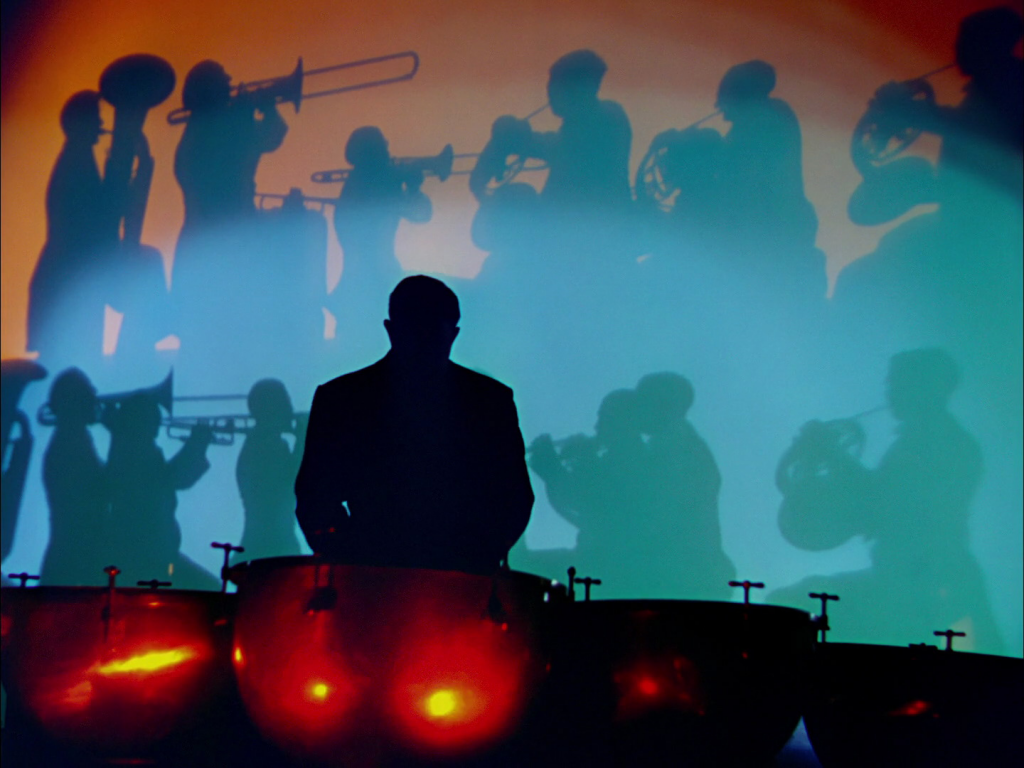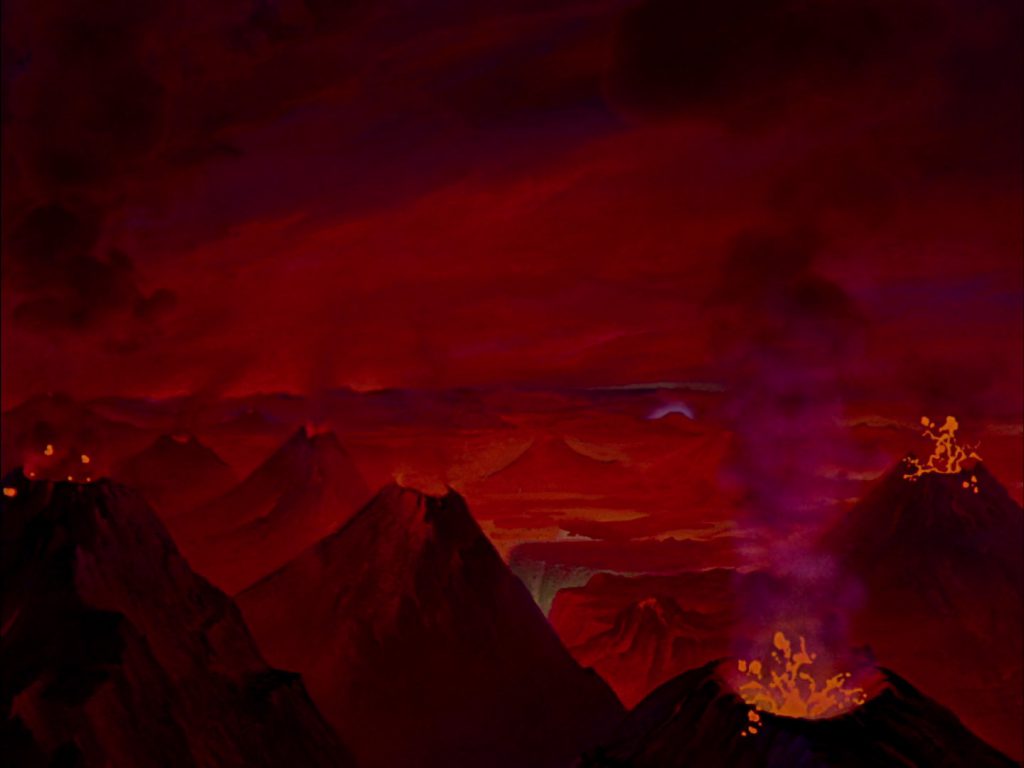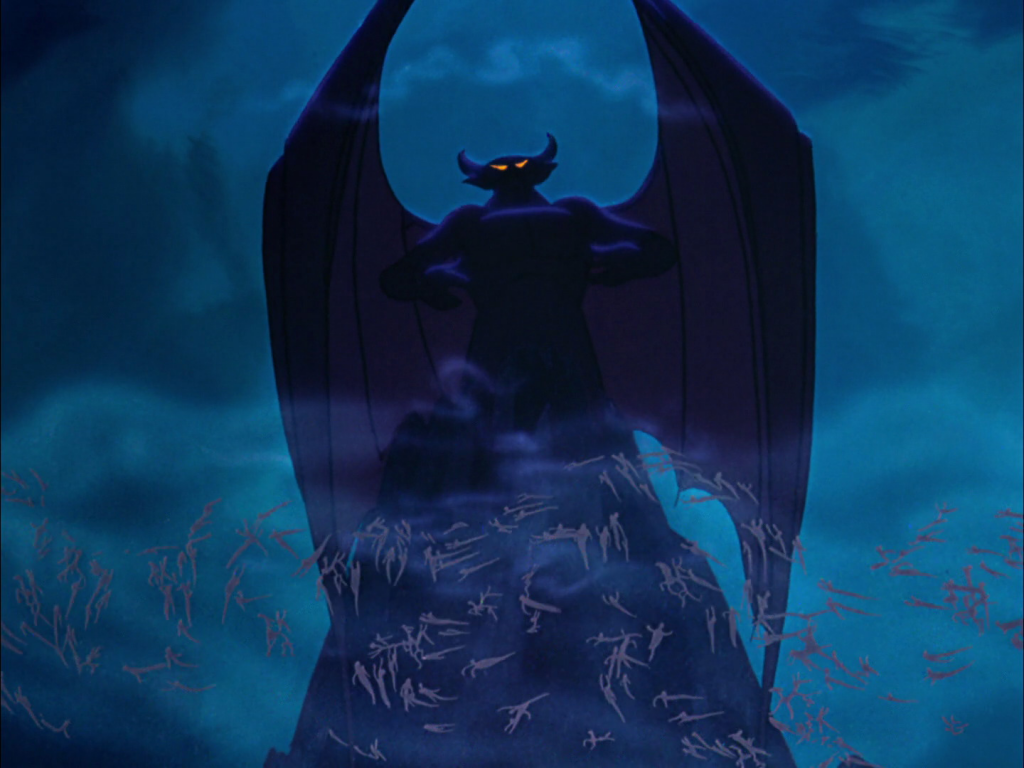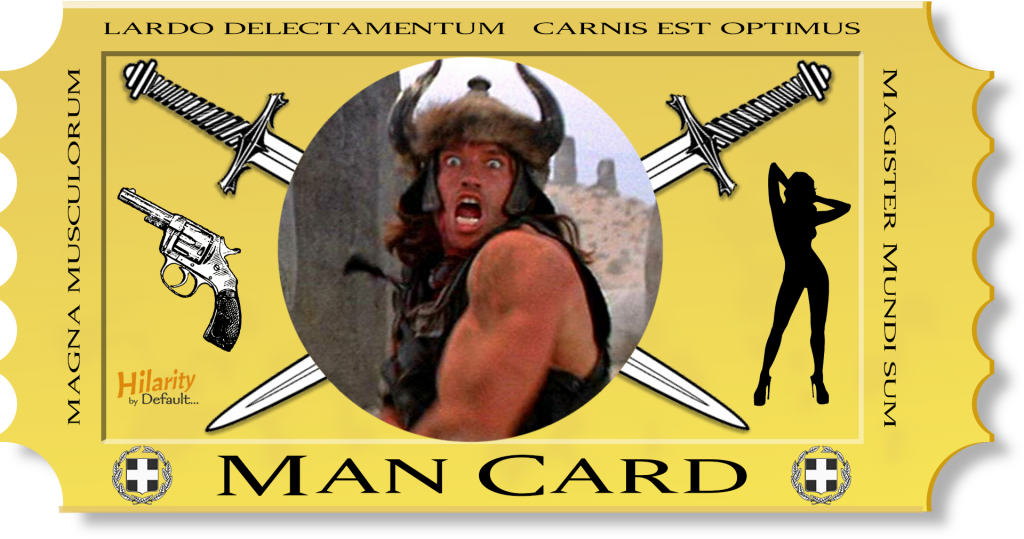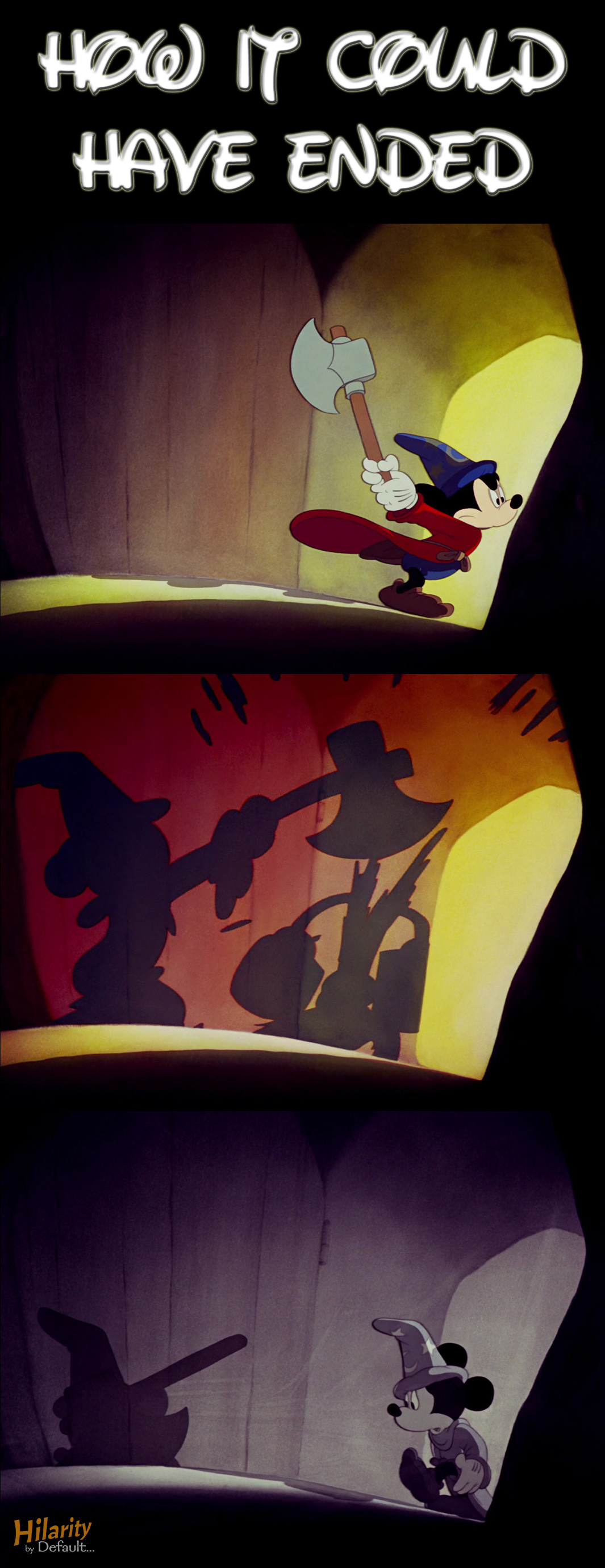1940 was an interesting year in the history of the Disney Studio. It saw the release of two full-length animated films (Pinocchio and Fantasia), one of the only times this happened in Walt Disney‘s lifetime. After the enormous success of Snow White and the Seven Dwarfs, the future seemed bright for the Studios. Productions were fast tracked and budgets began to rise. Walt built a new cutting edge studio and the animators were hard at work on some of the most artistically beautiful films ever made. Then this little thing happened:
So Disney responded the only way he could:
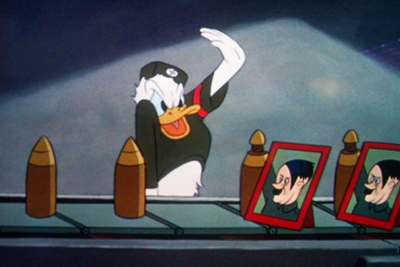
World War II, Package Features, & Dumbombers |
World War II cut Disney off from the lucrative European market. With the high production expenses of Pinocchio and Fantasia, Disney could not hope to recoup his losses and both films failed at the box-office. The next two years saw the studio release the last two traditional animated features for the decade – Dumbo and the long in production Bambi. Of the two, only Dumbo was a success due to its low production costs.

That is not to say that the Disney Studios didn’t keep busy for the remainder of the decade. Apart from a couple of live-action efforts and the release of many propaganda films and shorts (such as Donald Duck‘s “Der Fuehrer’s Face,” in which he has what can only be described as a flamboyant Nazi nightmare), Disney would only release what are now referred to as “package features.” These were animated collections of related shorts such as Saludos Amigos or The Adventures of Ichabod and Mr. Toad. Some were more successful than others but they only just managed to keep the studio afloat.
It wasn’t until the release of Cinderella in 1950 that Walt Disney truly returned to form; however, by the time Cinderella came out, Walt’s focus had begun to get distracted by a project far more ambitious – Disneyland.

With that said, it is a testament about how unequivocally special the creation of Fantasia truly was. It was pioneered during an all-time high at the Disney Studios in a period where Walt was thoroughly concentrated on expanding the realms of animation. No other film presentation of its kind had ever existed before or has since (Fantasia 2000, released sixty years later aside). Fantasia became a work of art brought to extraordinary life through timeless animation and music that to this day stands as one of the greatest animated works in history.
Walt Disney’s Fantasia |
Fantasia features a collection of seven animated sequences scored and choreographed to various pieces of classical music. Some tell a definitive story while others are abstract representations of moods, colors, and images that music can visually induce (without the use of recreational drugs which, incidentally, helped Fantasia become quite a success during a rerelease in the late 60’s and 70’s).
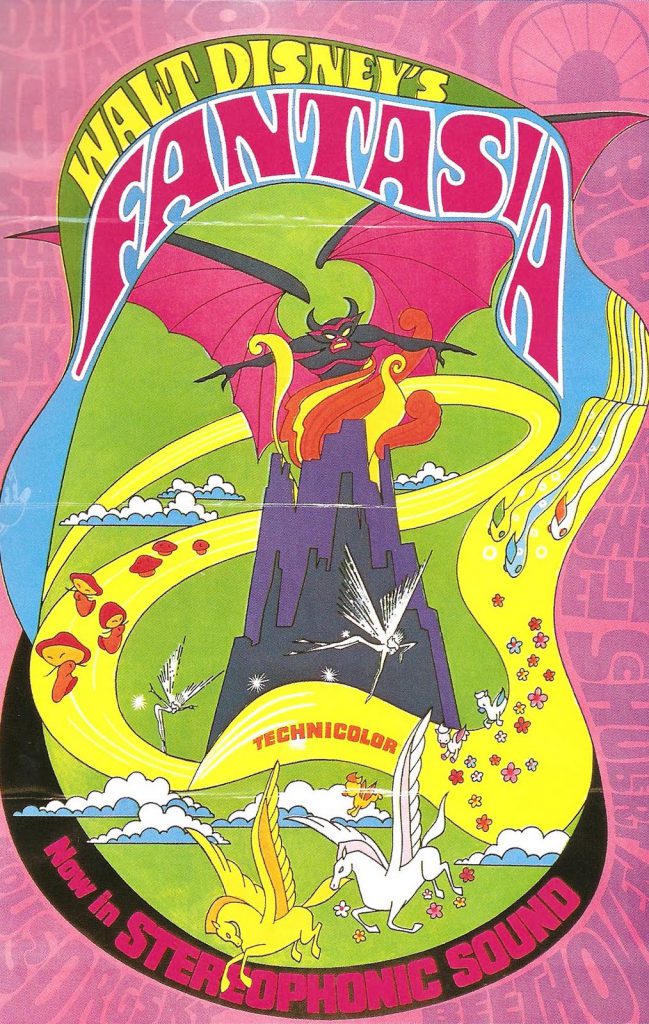
Work on Fantasia began with the production of an elaborate Mickey Mouse short adapting the story of “The Sorcerer’s Apprentice” set to the music by Paul Dukas. At the time, Mickey Mouse‘s popularity had dwindled considerably compared to the rising celebrity of Donald Duck and Walt wanted to alleviate this by creating a spectacular showcase for the character. The expense on the short rose considerably and Walt realized that the only way he could ever make a profit from it was to create a feature. With the partnership of famed composer Leopold Stokowski, Disney expanded the project into the film we now know.
Originally, Walt had hoped to have Fantasia be an ongoing theatrical experience with new sequences alternating regularly as time went on. It’s failure at the box-office, sadly, prevented this innovation from coming to fruition. Then again, one can only imagine what would have happened over the years if it had taken off:

For our review of Fantasia, we will focus on each individual sequence. They will all receive their own individual ratings which will be averaged into a cumulative final score at the end of the review. This same structure will be adapted for the upcoming reviews of the Disney “package features” as well (or any Disney film comprised of collections of animated shorts such as The Many Adventures of Winnie the Pooh).
Here’s a game for you: take a shot whenever someone yawns in the Fantasia. On second thought, please don’t! I don’t want to be responsible for anyone dying from alcohol poisoning. It wasn’t until my most recent viewing that I realized just how many characters yawn in the movie. It’s an epidemic!
Yawning aside, Fantasia opens sans credits to show an empty orchestra hall as a group of musicians begin to enter in silhouettes and perform some last minute tuning of their instruments evoking the feeling that you’re actually attending a live concert. Our host, composer and music critic Deems Taylor, approaches the stand and provides a droll introduction that will become commonplace throughout the film before each segment.
Toccata and Fugue in D Minor
|
5.0
|
The first section in Fantasia is unlike any other. In the words of Deems Taylor:
“So our picture opens with a series of impressions of the conductor and the players. Then the music begins to suggest other things to your imagination. They might be, oh, just masses of color or they may be cloud forms or great landscapes or vague shadows or geometrical objects floating in space.”
Since we see absolutely everything Deems just suggested, he is either going far too in-depth with his narration or he is the greatest psychic the world has ever known.
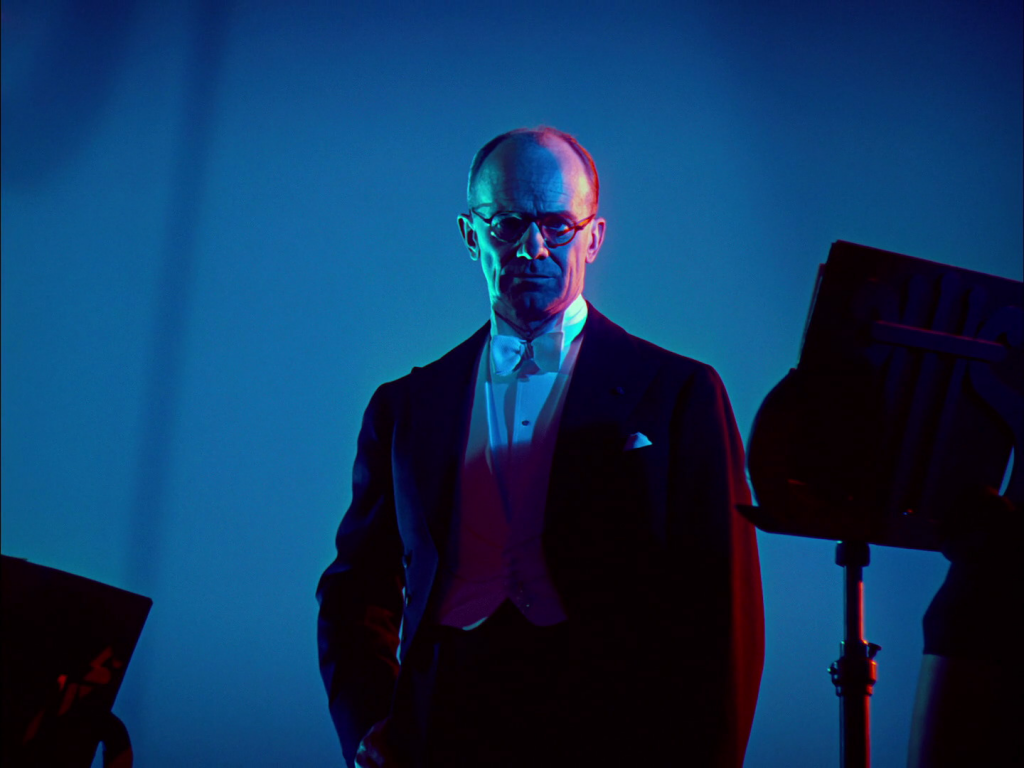
“Toccata and Fugue” has often been criticized as being the most boring sequence in Fantasia. I couldn’t disagree more. What could have been a dreary, bizarre mesh of discord and confusion instead becomes an abstract painting enlivened with pure inventiveness and imagination. In its own way, there is a chronology and an intelligent progression to the piece.
The sequence begins with the orchestra playing as lights and shadows begin to engulf the picture…
…before taking flight into their own separate entities. Shapes begin to form, reminiscent of the musical instruments playing. These instrumental shapes segues into more abstract forms and lines accenting the different beats in the music.
Finally, the whole sequence comes full circle to a spectacular crescendo with conductor Leopold Stokowski literally conducting the moving images.
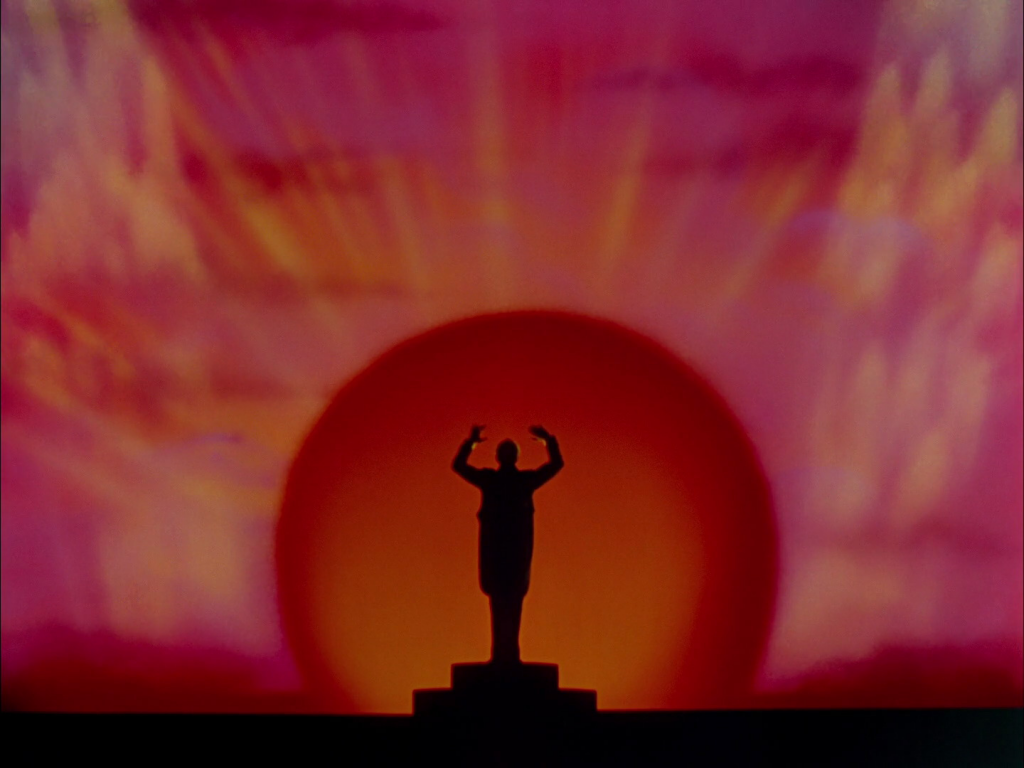
“Toccata and Fugue” shows the capability of the Disney animators when they let their imaginations run free. This is the most experimental piece in the picture and when I think of the pure concept of what Fantasia strived to be, this is the first piece that comes to mind. It sets the tone for the rest of the film and provides a fitting book end with the final segment, “Night On Bald Mountain.” “Toccata” ends with the birth of a new sun, a new day. “Bald Mountain” finishes the film with the mystery and horrors of night before it too dissolves into the rising morning sun of the following day. Subtly, this gives an irregular film like Fantasia a good dose of symmetry that helps make it a more complete picture. The theme of “beginnings and endings” is also further explored within each segment, whether it is shown through the changing of the seasons (“Nutcracker Suite”), the rise and fall of the dinosaurs (“The Rite of Spring”), or the many cases of characters falling asleep and waking up (i.e., lots and lots of yawning).
The animation is dazzling and the music by Bach is, need I say more, extraordinary making “Toccata and Fugue” a worthy introduction to Fantasia.
Nutcracker Suite
|
5.0
|
The “Nutcracker Suite” is my favorite part of Fantasia bar none. If someone ever held a gun to my head and asked that I pick a representation of the greatest animated sequence ever put on film, I’d be tempted to cite this piece (especially the final “Waltz of the Flowers” segment).
Unlike the majority of his introductions in the film, Deems Taylor is unusually brief here and thankfully so. It is strong enough to stand on its own and Walt Disney‘s decision to switch this from a reenactment of the Nutcracker story to a representation of the seasons was a brilliant one. After viewing this sequence, it is almost suggestive that this is what the music was originally meant for. It works that well.
The “Nutcracker Suite” begins with the coming of spring as a group of nubile young fairies awaken and begin to transform the landscape to the tune of “Dance of the Sugar Plum Fairy.”
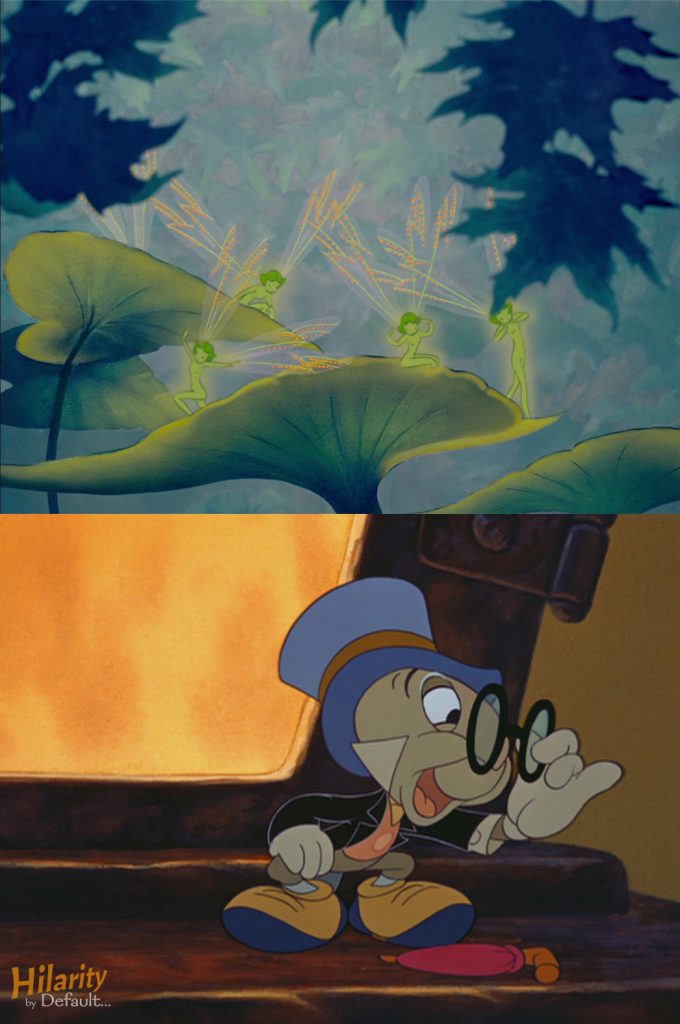
As spring turns into summer, we begin seeing the plants and animals join in on the action. The “dance” of the fish during the “Arabian Dance” portion of the piece is its slowest, albeit most sensual, section. Although the “Nutcracker Suite” is full of nude female fairies, it is almost hilarious when you realize that its most provocative bit is dominated by sensuous fish!

Luckily, a grand dose of energy in the form of “The Russian Dance” follows before seguing into “The Waltz of the Flowers” which represents the fall and winter seasons. This is the most spectacular section and a fitting climax to an already incredible sequence.
If “Toccata” represents an abstract painting come to life, then “Nutcracker” can fairly be described as an animated oil painting. Scored to the infamous music of Tchaikovsky, “Nutcracker” is incomparably beautiful and a true masterpiece from the Disney Studios.
The Sorcerer’s Apprentice
|
5.0
|
“The Sorcerer’s Apprentice” is the segment that began it all and has become Mickey Mouse‘s most famous role. It is the most recognized section of Fantasia and, in my opinion, there has never been a more perfect marriage between a piece of classical music and an animated story. Upon hearing the well-known melody of the composition, it is doubtful that anyone doesn’t immediately recall the image of Mickey bringing broomsticks to life and controlling the cosmos.
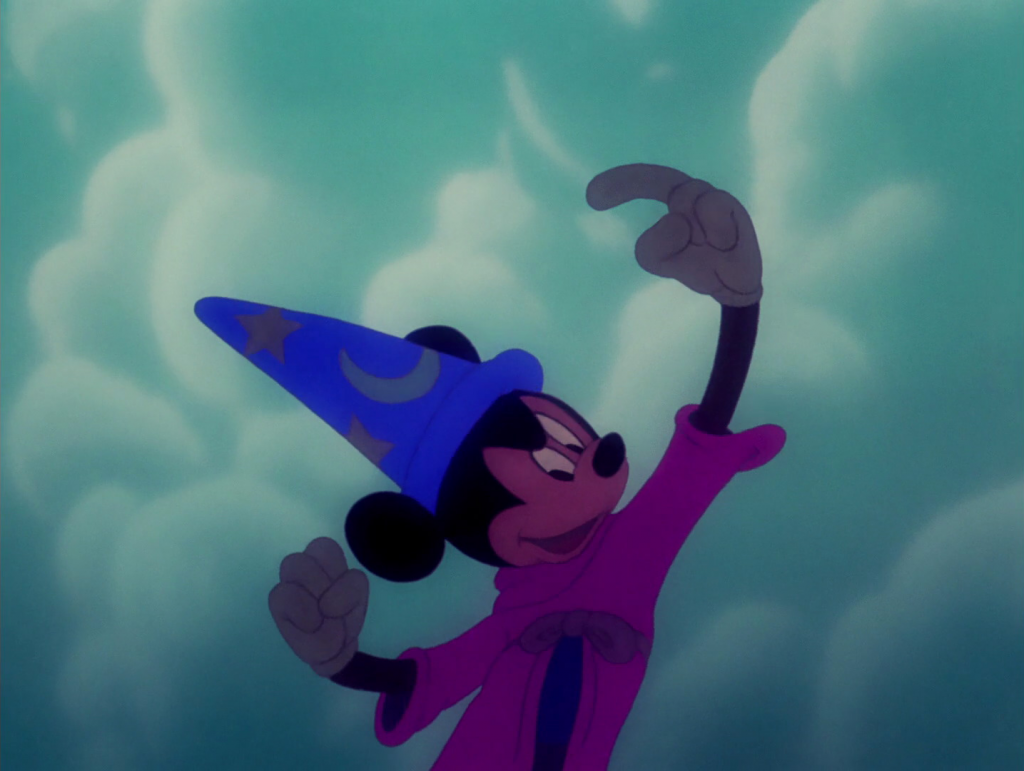
Thankfully, the omniscient Deems Taylor restrains himself and only describes the first 8 minutes of this 9 minute production. It is entirely unnecessary as the story is quite simple and told splendidly within the piece itself.
We begin with a masterful sorcerer named Yen Sid (Disney backwards) who, after a full day of practicing spells, grows fatigued and leaves his supernatural hat behind to take a nap.
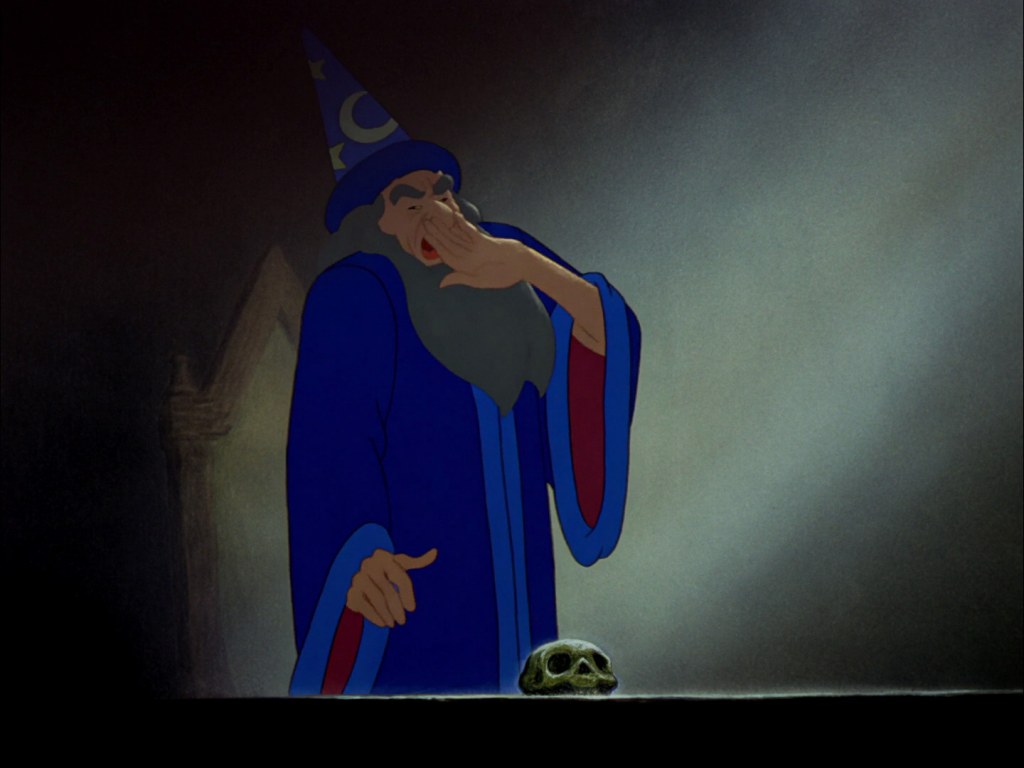
Enter our every-man apprentice – Mickey Mouse – who cannot resist the temptation to take the hat and attempt some magic of his own to alleviate his workload (of endlessly carrying buckets of water back and forth, I guess). Apparently, Yen Sid’s fatigue is contagious because our sorcerer’s apprentice grows weary and falls asleep himself.
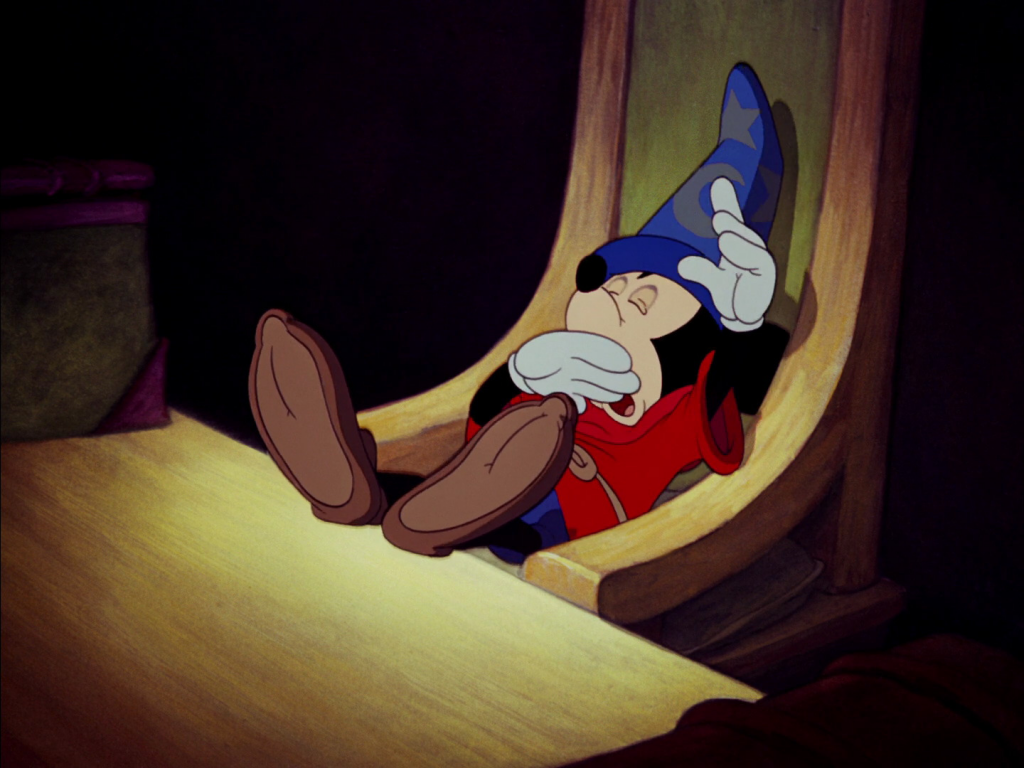
Mickey wakes up to find pandemonium reining as his spell has grown completely out of control and the dungeon begins to flood. Thankfully, the all powerful Sid returns in time and, in the great tradition of Moses, literally parts the waters to regain command of the situation.
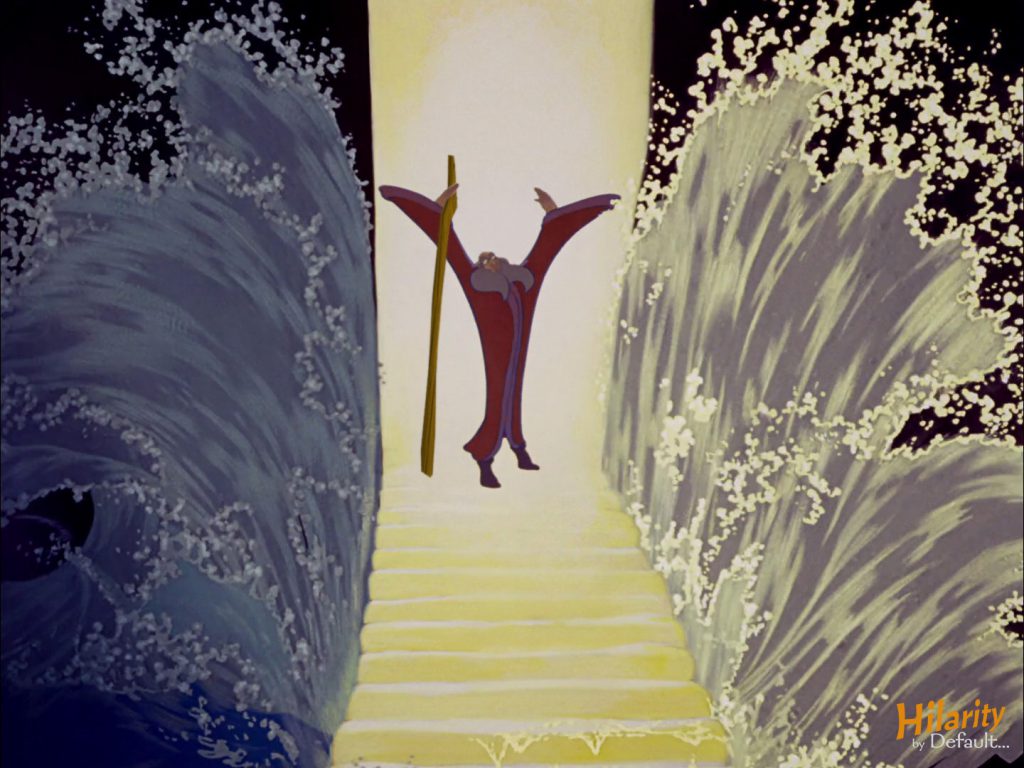
“The Sorcerer’s Apprentice” is a delight. Mickey Mouse is as endearing and personable as ever and his use here is absolute perfection. With stunning animation and music, it is one of Disney’s all-time classics.
Rite of Spring
|
3.5
|
“Rite of Spring” is one of the most acclaimed (and controversial) sequences in Fantasia. Contrarily, I find it to be the weakest portion of the film. Sure, the animation is fantastic and the thematic representation of the origins of life is epic, but its length (at nearly twenty minutes!) and slower pace can be overwhelming. It doesn’t help that Stravinsky’s composition is by nature chaotic and varies frequently in tone and tempo.
Of course it is this very chaotic trait that marks this as the perfect musical arrangement to score the emergence of life and atmosphere on earth. Appropriate yes, but it doesn’t necessarily make it enjoyable. As if to accentuate the turmoil of the piece, as soon as Deems Taylor names the segment, the musicians lose control of their instruments:
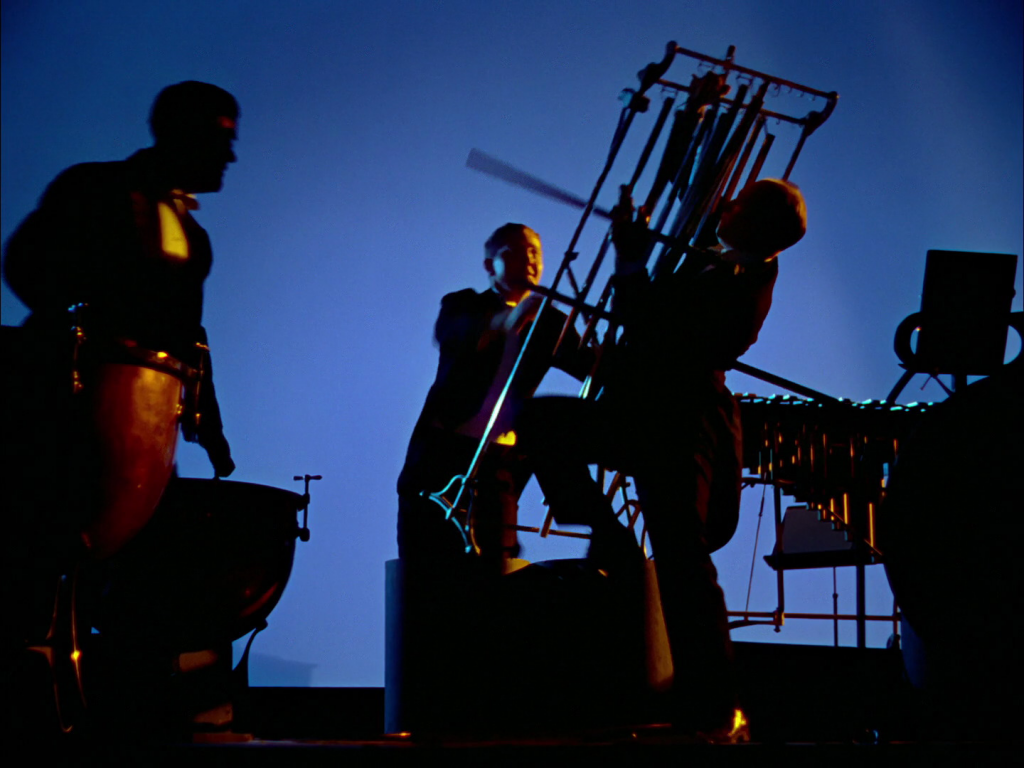
Once again, we are treated to the over-narration of Deems Taylor, who not only describes the entirety of the story but the conclusion as well! “The dinosaurs were wiped out,” he explains, “That is where our story ends.” Gee, thanks for the spoiler alert, Deems!
The original “Rite of Spring” tells the story of the coming of springtime where a nubile young virgin is chosen to partake in a primitive ritual where she performs a sacrificial dance to the death. As fascinating as it would have been to see Disney’s animated version of this, the change in story is apt and it works well within the composition’s framework.
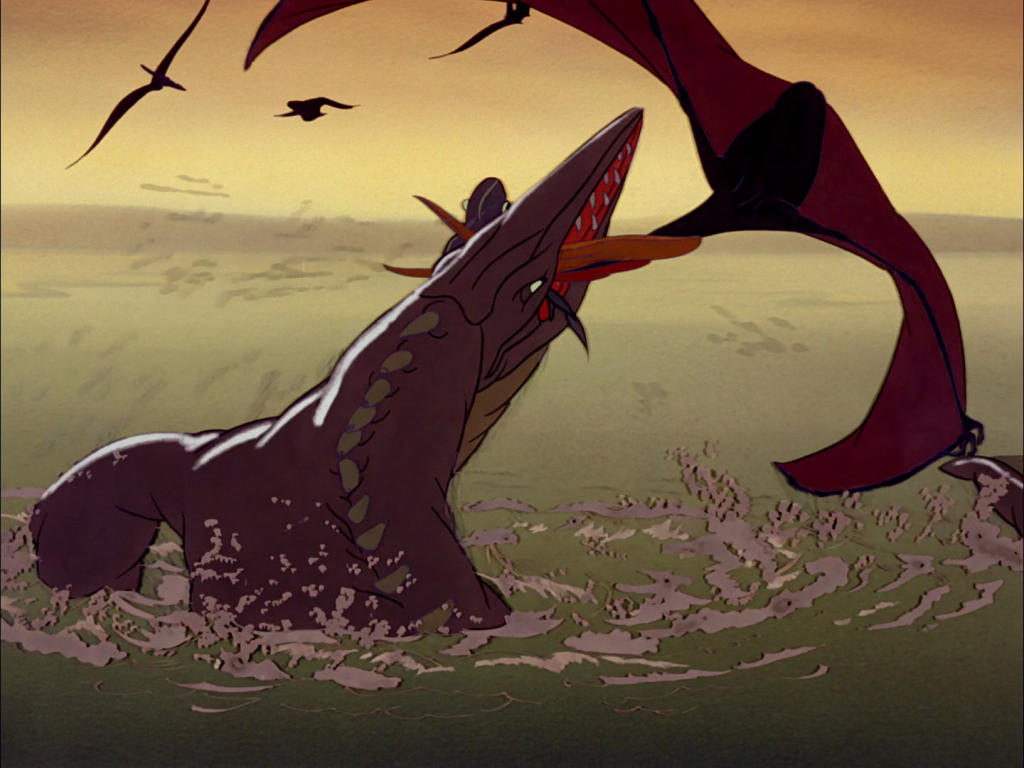
Disney’s “Rite of Spring” commences with the creation of the universe and the birth of the planet earth as wind, rain, and land collide into a formative dance. This section holds my favorite part of “Spring” where volcanoes form and explode in breathtaking bursts of lava and wind. It helps that this is also the most melodic part of Stravinsky’s work.
We transition next to the creation of life as amoebas conjoin and develop into more complex organisms. The (literal) black cloud of evolution progresses the scene into the advancement of primitive sea creatures. It is here where the subject of death is introduced. It’s clear that this isn’t the carefree underwater world of The Little Mermaid.
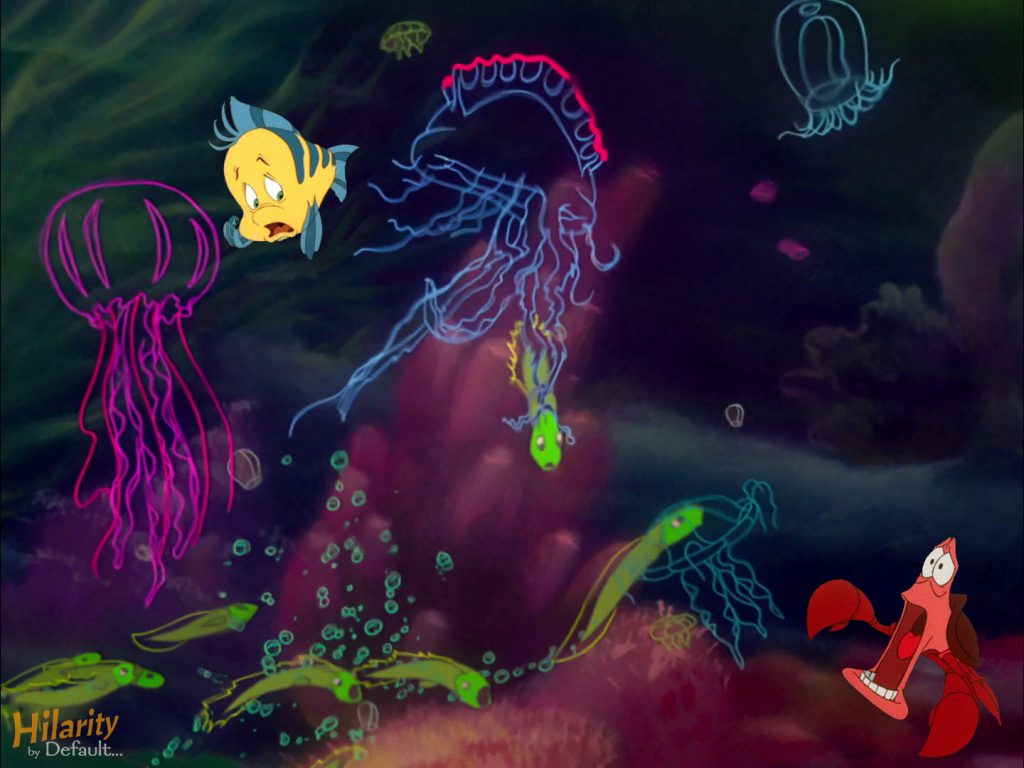
Eventually (halfway through “Spring”), we see the advent of the dinosaurs. Unlike most Disney animated films to this point, the animation of the animals, in this case the dinosaurs, strives for anatomical authenticity. In many ways, this was the Jurassic Park of its time. Audiences had never seen dinosaurs depicted in such a corporeal level before.
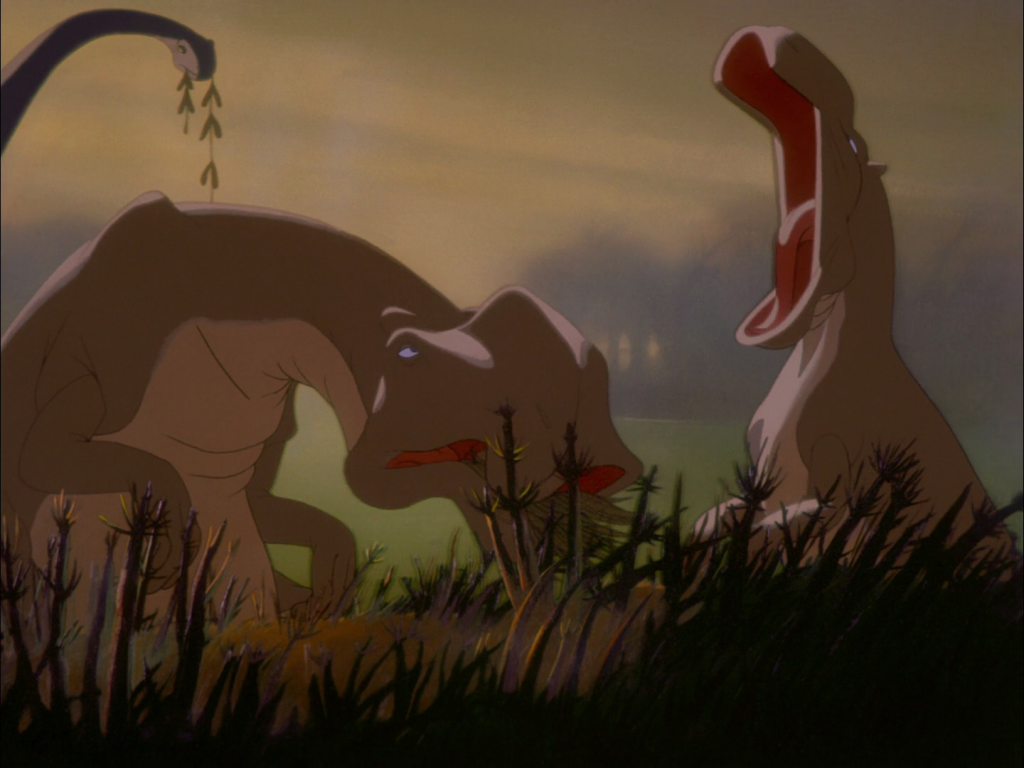
After a terrifying fight between a tyrannosaurus rex and a stegosaurus (although chronologically unsound since they didn’t exist during the same time period), we are treated to the most depressing ending in Fantasia as we slowly watch all the dinosaurs march to death before catastrophic earthquakes overtake the earth, in true Michael Bay fashion, to spark a new beginning.
Scientific understanding of the time period has advanced significantly since Fantasia was produced but it doesn’t lessen the impact “Rite of Spring” has. It is refreshingly bold to see such a scientific depiction in a Disney film. Interestingly enough, Walt Disney was originally going to also portray the birth of mankind but balked at the possibility of offending Creationists at the time. Although it has its share of flaws, the animation is inspiring and while I wouldn’t count “Spring” as a highlight in Fantasia, it is daringly stunning.
After a short intermission and an impromptu jazz session among the musicians, our overindulgent host Deems Taylor takes us on a brief diversion:
“I’m very happy to have this opportunity to introduce to you the soundtrack.”
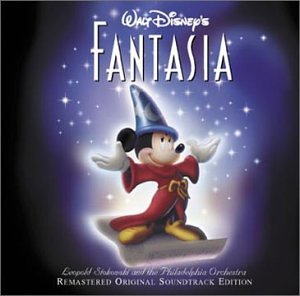
A shy, animated line pops into the picture representing the film’s own soundtrack and we’re shown the effect music has on it:
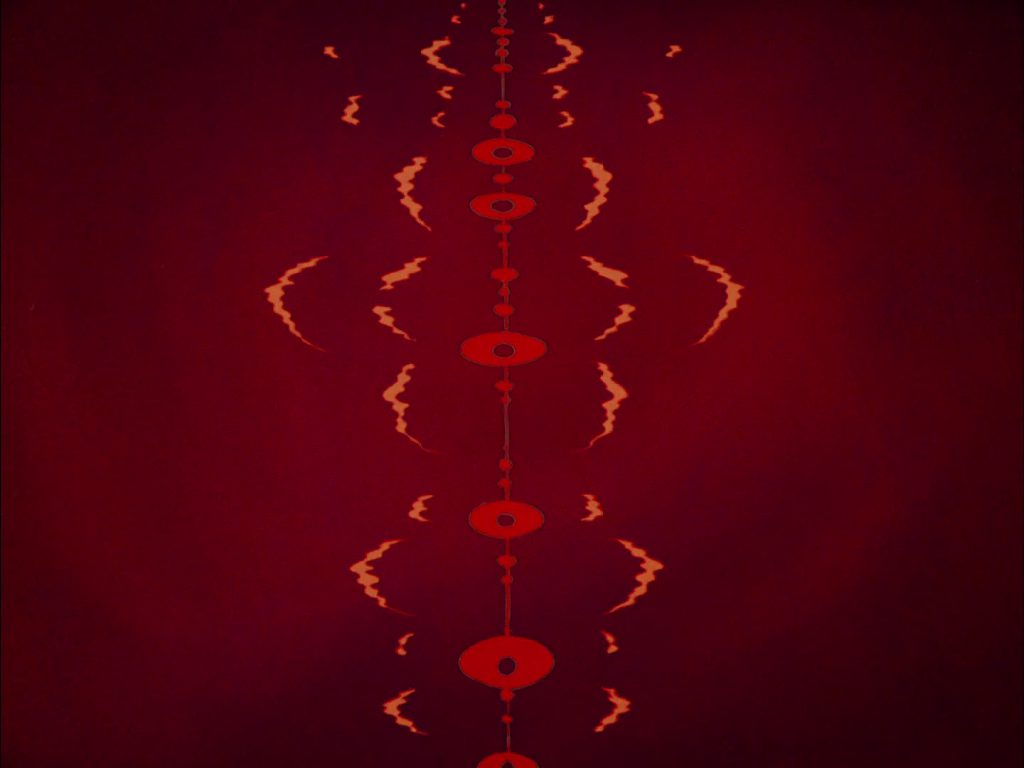
It’s an amusing short sequence and one that would be further explored to greater effect four years later in The Three Caballeros.
The Pastoral Symphony
|
4.0
|
Following the grim “The Rite of Spring,” “The Pastoral Symphony” provides a large dose of relief. Contrasting “Spring’s” gloomy and bleak palette, “Pastoral Symphony” is gleaming with color and cuteness – sometimes overbearingly so.
Deems Taylor’s over-description reaches new heights as he not only explains the whole story but goes on to name each and every character that appears in the “Symphony.” By the time he gets to describing Vulcan forging thunderbolts, I was praying for a Vulcan neck pinch.
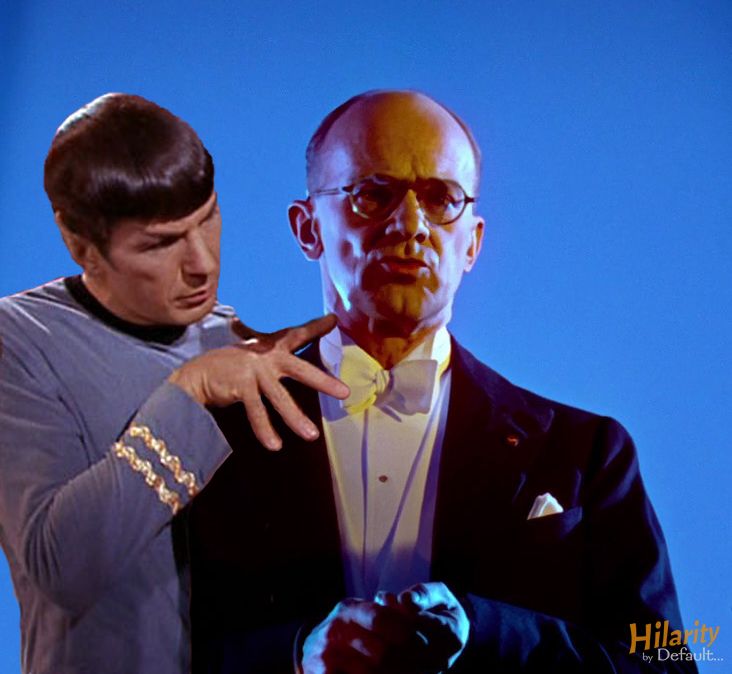
The first few parts of “The Pastoral Symphony” focus on several vignettes such as unicorns frolicking, a baby pegasus learning to fly, and…
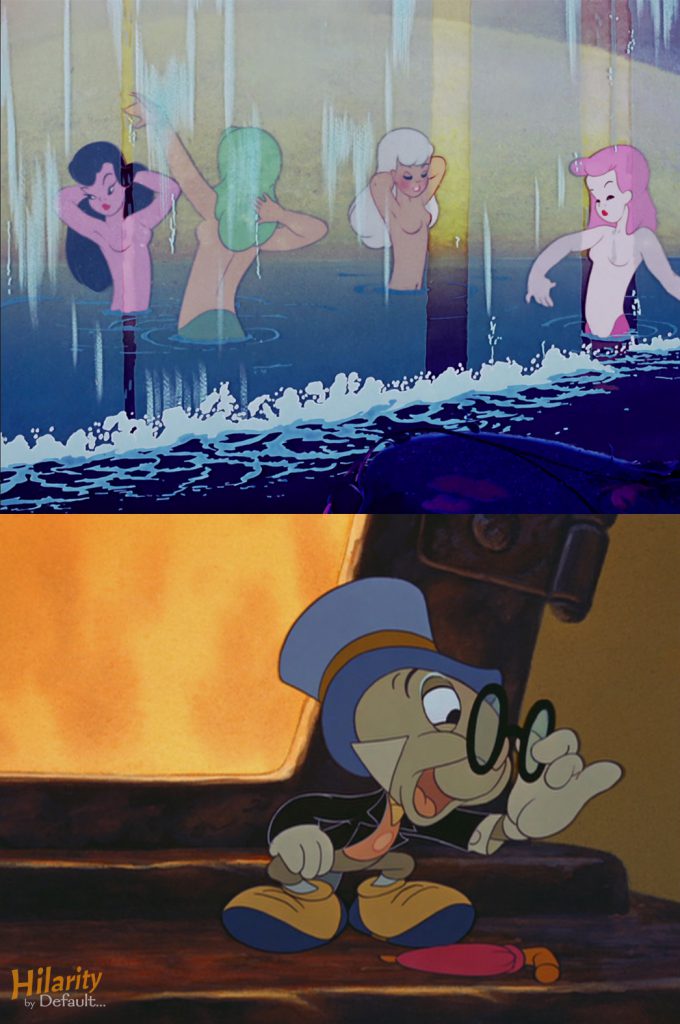
…um, some bathing centaurettes grooming themselves to find an eligible bachelor. Much has been said about the depiction of the topless centaurettes but the scene is innocuous and only amplifies the virginal beauty of the characters before they find their mates. The centaur section has a simple sweetness to it without being overtly flamboyant with the exception of those cloying, benevolent cherubs who are dripping with such bountiful cuteness as if it were a disease.
The second half of “Symphony” features all the characters joining together to hold a festival in honor of Bacchus, the ever-inebriated god of wine. Make that exceedingly inebriated. He makes Jack Sparrow look sober by comparison.
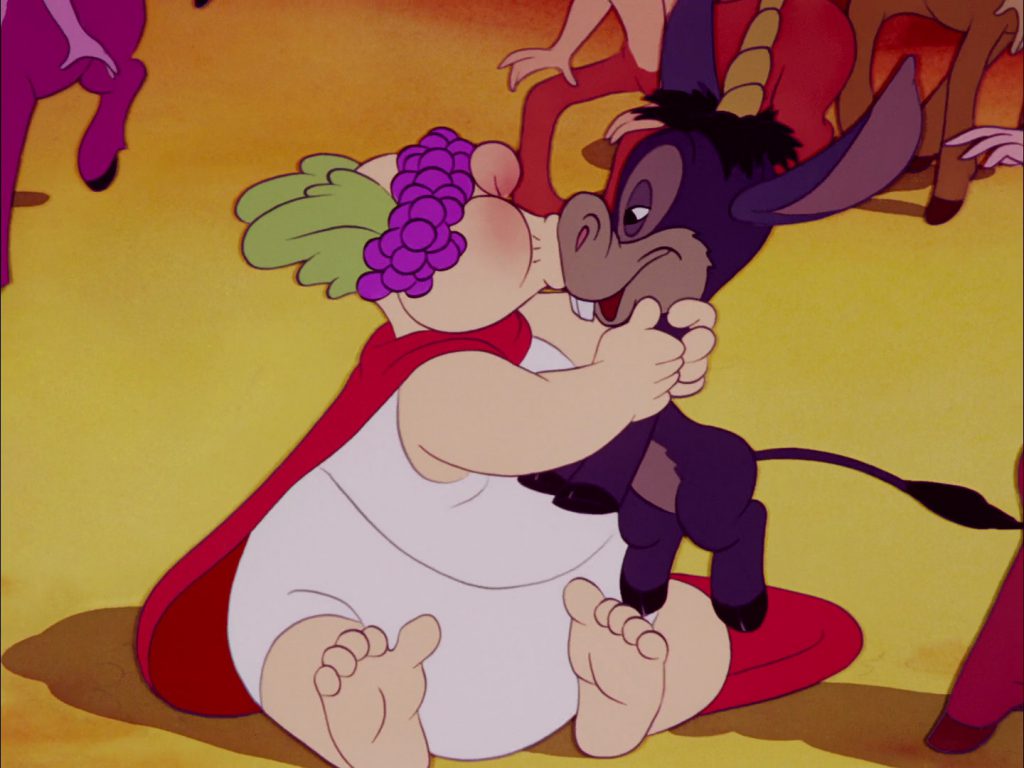
Much dancing and frolicking ensues until the almighty Zeus decides to throw some lightning into the mix as a mighty storm disrupts the festivities. All ends well the following morning as a rainbow appears and all the characters come together once again and rejoice.

It’s interesting to note that “The Pastoral Symphony” is the single most controversial segment in Fantasia. While “Rite of Spring” has been opposed for its depiction of evolution and “Night on Bald Mountain” for its demonic imagery, “Pastoral Symphony” has been lambasted for racial stereotypes. Most specifically because of its inclusion of a character named Sunflower.

Doesn’t seem familiar? She was edited out of Fantasia during its 1969 rerelease to avoid controversy and hasn’t been seen since. Sunflower is unquestionably a stereotype and it’s easy to see how the general public would get a sour impression as the years went by; however, it does raise one of my pet peeves in that Disney advertises the DVD/Blu-ray release as “Walt Disney’s Original Uncut Version” when it is clearly censored – you can’t have it both ways!
Regardless, “The Pastoral Symphony” is a vibrant watercolor painting, brimming with charm and character. It may not be the most memorable sequence in Fantasia but, with an appealing composition by Beethoven, it is a breath of fresh air from its darker predecessor. And speaking of fresh air, it thankfully doesn’t include too much yawning…
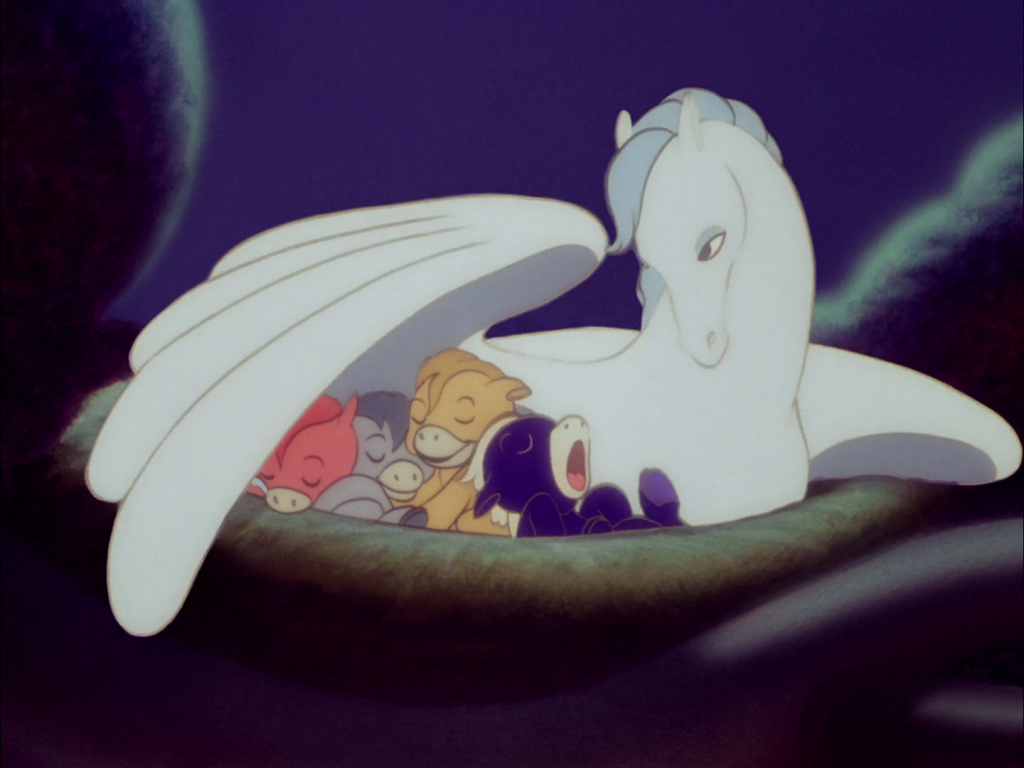
Dance of Hours
|
4.5
|
“Dance of Hours” is Fantasia‘s pure comic sequence. What it lacks in animation quality in comparison to the rest of the film, it makes up for with laughs and energy.
We begin with what may be the most effective introduction Deems Taylor gives in the film. Although his description of the plot is once again excessive, his sedate narration becomes part of the joke. He describes the ballet with the utmost reverence without revealing that it is performed entirely by animals! For once, it works brilliantly.
This substitution of various animals for ballet dancers which include dancing ostriches…

…to hippos in tutus…
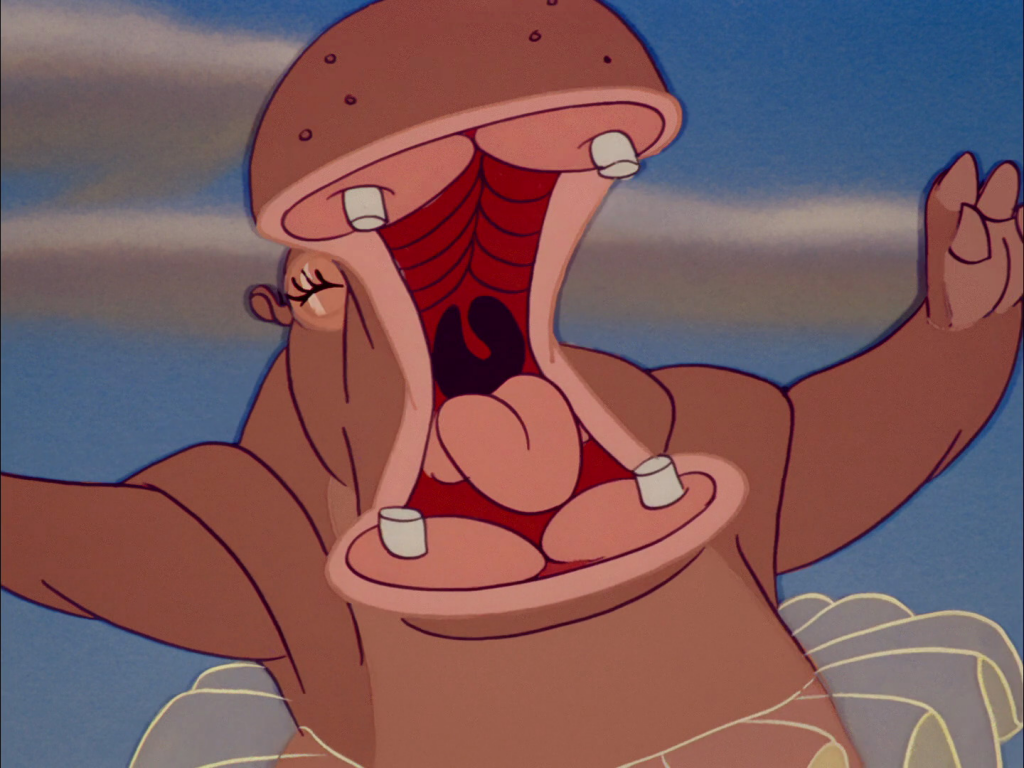
…to bubble blowing elephants, is ingenious and ripe for comedy. On a side note, I have always wondered what Walt Disney‘s fascination with surreal elephant figures was. Other examples would be the “Pink Elephants on Parade” nightmare from Dumbo (for which this is a precursor to) and “Heffalumps and Woozles” from The Many Adventures of Winnie the Pooh.

The last two portions of “Dance of Hours” are kicked off by the arrival of Ben Ali Gator and his posse of alligator dancers. All hell breaks loose to the upbeat tempo of Ponchielli’s music to bring the piece to a zany close. With the exception of “The Sorcerer’s Apprentice,” this is perhaps the most well-known section of Fantasia, especially among children, and it’s easy to see why.
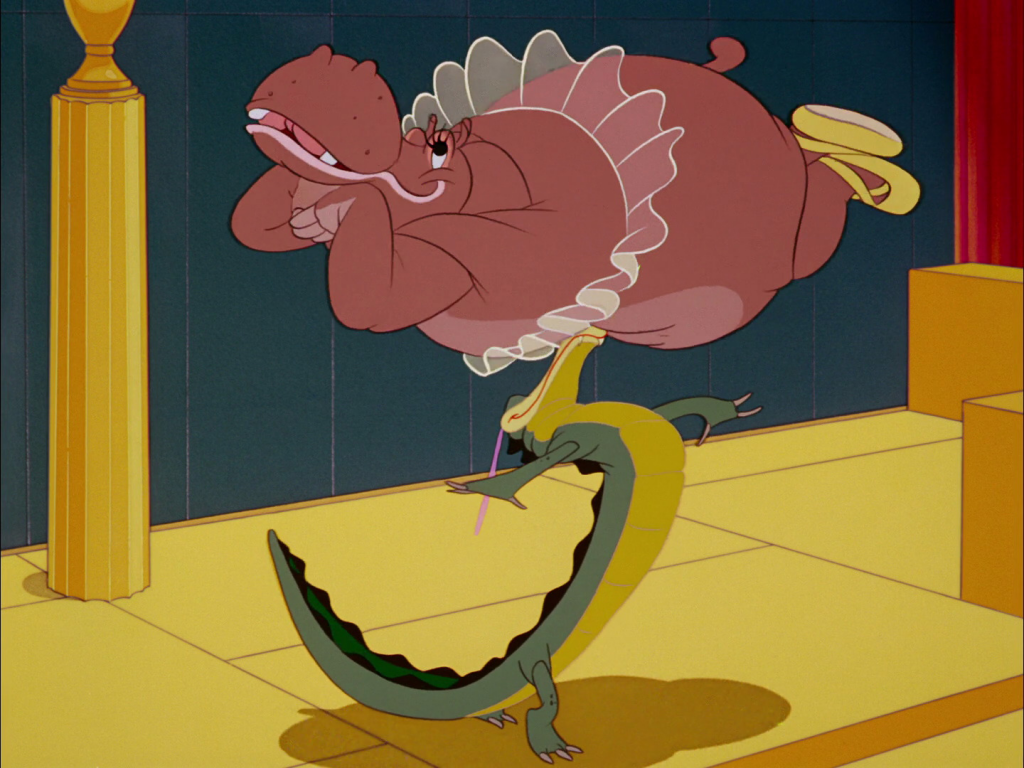
Night on Bald Mountain & Ave Maria
|
5.0
|
“Night on Bald Mountain” is the single darkest piece of animation the Disney Studios ever produced. It pushes many boundaries and it is surprising that it subsequently not only achieved a G-rating but that it wasn’t also banned or censored by the Hayes Code of decency in effect at the time. Although the Hayes commission gave Walt strife for the topless centaurettes (they were originally topless throughout the whole “Pastoral Symphony”), it is astonishing that they were able to get away with so much here.
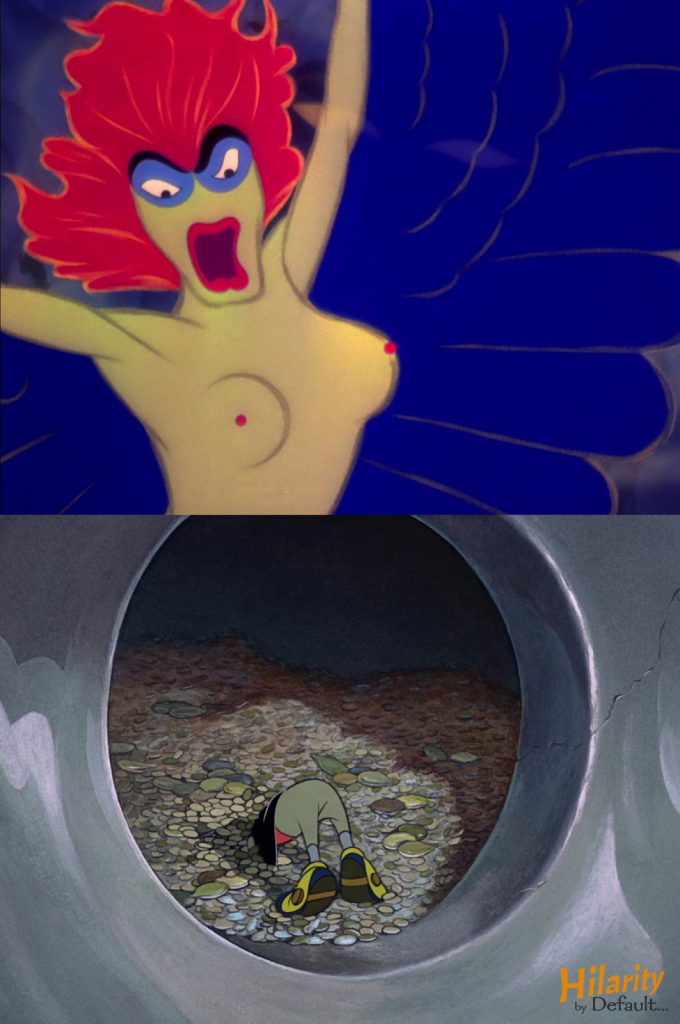
“Bald Mountain” triggers its spell on Halloween night where Satanic forces engulf a small village under the command of the imposing Chernabog as he raises the dead from their graves to celebrate in a haunting dance of despair and agony.
All sorts of spirits and demons rise from their graves to cavort with doom. At one point, Chernabog transforms flames into nubile dancing girls before he cruelly disfigures them into hideous creatures and drops them into a fiery demise.
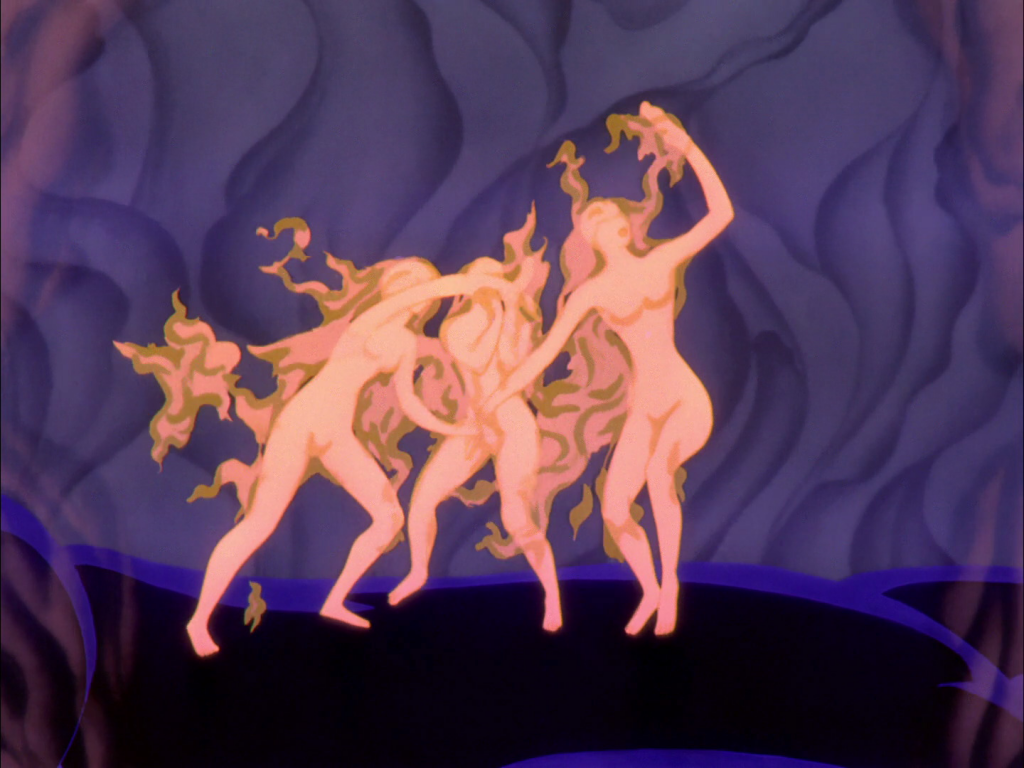
Chernabog’s orgy of death is soon extinguished by the sounding of church bells and a morning prayer service as the sequence segues into “Ave Maria.” The juxtaposition of “Ave Maria” with “Bald Mountain” works surprisingly well. For a film that has some of the darkest scenes and adult imagery in a Disney picture, it is interesting that it concludes in a church setting.
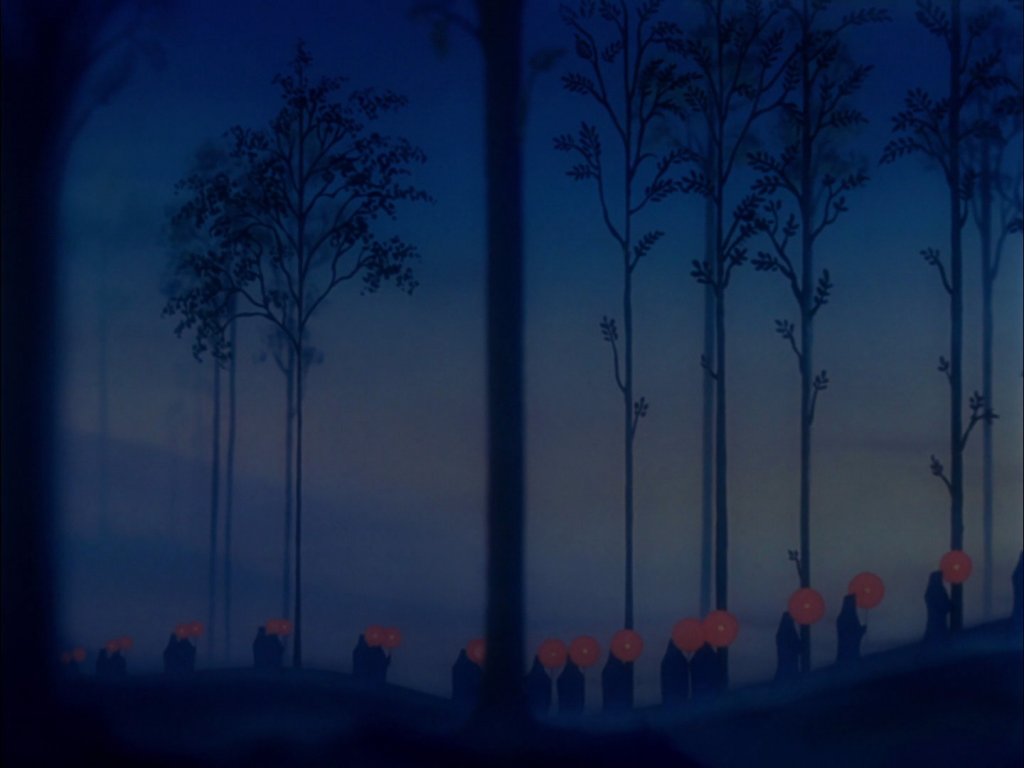
“Night on Bald Mountain” is a haunting masterpiece. Mussorgsky’s composition is reaping with a sinister ambiance that is matched impressively by the animated visuals. The subject matter and mature representations have been a topic of debate but their depiction is breathtaking. The protrusive portrayal of evil animated in “Bald Mountain” makes its ultimate defeat in “Ave Maria” much more powerful marking it as a fulfilling ending to Fantasia (once again, sans credits).
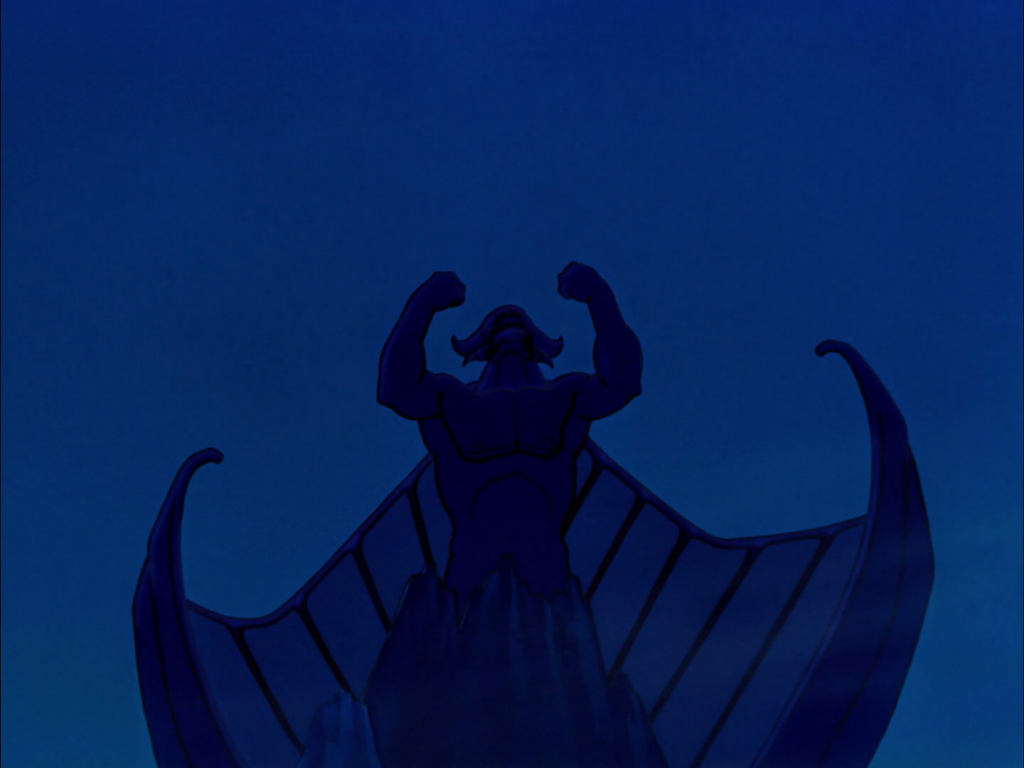
Final Thoughts |
Fantasia is an incomparable experience. While Disney did produce a sequel nearly sixty years later with Fantasia 2000, it could not live up to the extraordinary artistry and genius of the original (although it was a valiant effort). While it is blemished to a small degree by a long running time and the egregious narration by Deems Taylor, it does not affect the competence and imagination of what is truly an incredible achievement.
Man-Card Retribution |
I have often received strange looks when I mention that Fantasia is one of my all-time favorite Disney films. The very thought of an entire animated movie scored to classical music is enough to make many people hesitate from giving it a proper chance.
Fantasia, more than any other entry in the Disney animated canon, is a film that is mostly geared towards adults. Even Deems Taylor’s narration is articulate and never particularly patronizing. Its explorations of life, death, sex, and melody are unlike anything that the Studio ever produced. It is an absolute symphony of animation.

Man-Card Verdict: +1
Random Afterthoughts… |
Has anyone ever noticed how in “The Pastoral Symphony,” all the centaurs match up to the centaurettes according to color? I guess it’s a way to keep their races pure?
Just how many close-ups of the sun or sunset are there in this movie? It almost gives the constant yawning a challenge!

Somehow, Yen Sid’s smoke monster looks vaguely familiar…
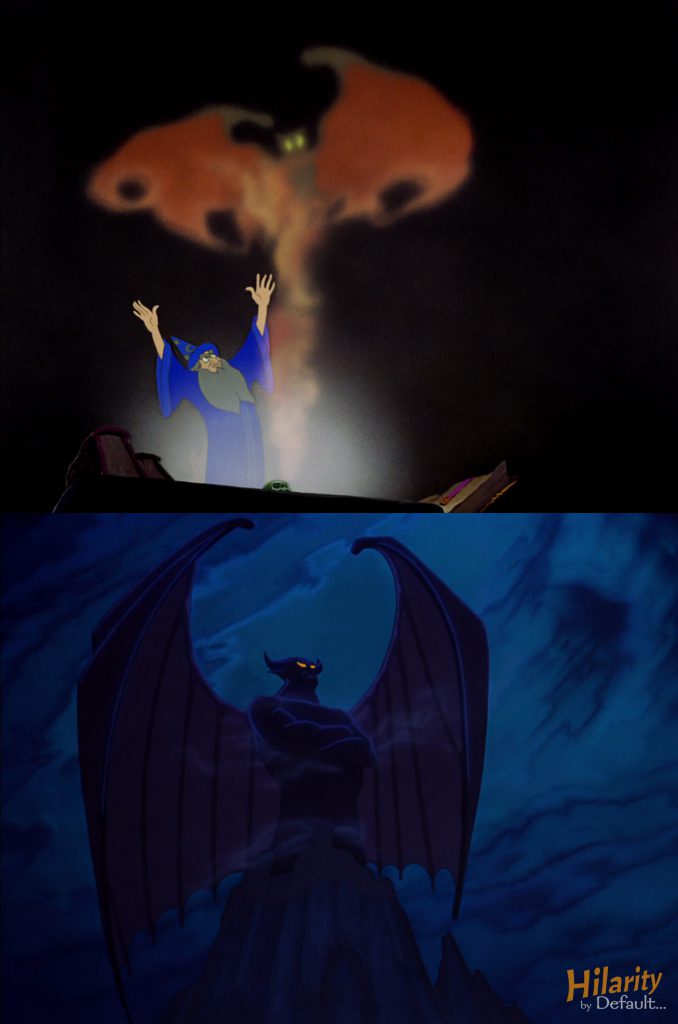
Join us next time when Mickey trades in his sorcerer getup to become a gaucho in his second screen adventure, “The Gallopin’ Gaucho” (1928). For more Default Disney, click here.














